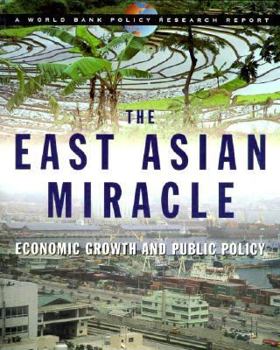The East Asian Miracle: Economic Growth and Public Policy
Select Format
Select Condition 
Book Overview
The extraordinary growth enjoyed over the last several decades by many East Asian countries has amounted to nothing less than an economic miracle. Employing unorthodox policies, Hong Kong, Indonesia, Japan, Malaysia, the Republic of Korea, Singapore, Taiwan, and Thailand have all produced dramatic results with far-reaching improvements in human welfare and income distribution, leading many to ask whether a similar achievement can be duplicated elsewhere.
Written for the nonspecialist, this World Bank Policy Research Report--the first in an important new series--discusses in detail the means by which these high-performing Asian economies (HPAEs) realized their staggering success between 1965 and 1990. Examining how these countries stabilized their economies with sound development programs that led to fast growth, the book also shows how they shared the new prosperity by making income distribution more equitable.
The book makes clear how the HPAEs promoted rapid capital accumulation by making banks more reliable and encouraging high levels of domestic savings, while universal primary schooling and better primary and secondary education quickly increased their skilled labor forces. Also included are illustrative examples of productive agricultural programs, modest tax policies, the modification of price distortions, foreign technology and investment, and the cooperation of government and private enterprise.
Exposing to a broad audience the revolutionary process that transformed East Asia into the collection of economic juggernauts that it is today, this provocative World Bank report offers wisdom for today's up-and-coming markets, highlighting the policies that will make a difference as well as those that, despite their effectiveness in the Orient, could prove disastrous elsewhere.
Written for the nonspecialist, this World Bank Policy Research Report--the first in an important new series--discusses in detail the means by which these high-performing Asian economies (HPAEs) realized their staggering success between 1965 and 1990. Examining how these countries stabilized their economies with sound development programs that led to fast growth, the book also shows how they shared the new prosperity by making income distribution more equitable.
The book makes clear how the HPAEs promoted rapid capital accumulation by making banks more reliable and encouraging high levels of domestic savings, while universal primary schooling and better primary and secondary education quickly increased their skilled labor forces. Also included are illustrative examples of productive agricultural programs, modest tax policies, the modification of price distortions, foreign technology and investment, and the cooperation of government and private enterprise.
Exposing to a broad audience the revolutionary process that transformed East Asia into the collection of economic juggernauts that it is today, this provocative World Bank report offers wisdom for today's up-and-coming markets, highlighting the policies that will make a difference as well as those that, despite their effectiveness in the Orient, could prove disastrous elsewhere.
Format:Paperback
Language:English
ISBN:0195209931
ISBN13:9780195209938
Release Date:September 1993
Publisher:Oxford University Press, USA
Length:408 Pages
Weight:1.75 lbs.
Dimensions:0.9" x 7.5" x 9.2"
Customer Reviews
1 rating
Good pre1997 crisis book, interesting contradictions
Published by Thriftbooks.com User , 21 years ago
This book explores the causes for the extraordinary growth experienced by a few Asian countries in the pre-1997 crisis era. It describes, in great detail, the policies adopted in each country that are believed to have spurred such development; to its credit (being a World Bank book), it even suggests that some unorthodox policies may have been beneficial, even though it does suggest that these benefits are not there to be reaped again by a country trying to emulate them. One of the main arguments is also that income distribution improvements have been a common experience across these countries, which is a topic not often discussed in development economics.There are, however, some obvious fallacies in this book. Having been written pre-1997 crisis, it does highlight the strenght of the banking system in many of these countries; these banking systems were later to be blamed for much of the pain in the 1997 crisis.I find this book fascinating, not as a source of development ideas (those can be found elsewhere), but due to the historical context in which it was written (praising economies that were about to collapse). Of course, these economies are still better off that most developing countries, so I do not believe that they are mistaken in many points, but there are certain contradictions that arose with the crisis that make it worth reading this book to determine what is good advice and what is hot air.






